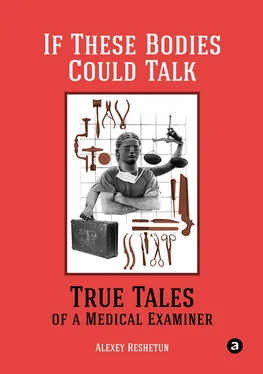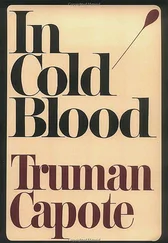People's ideas of what happens at an autopsy are often founded on rumors, tall tales, and superficial knowledge of human anatomy (recently, some educated adults asked me, with straight faces, if a person's eyes fall out of their sockets when you remove the brain from their skull). It is natural, as the average person never needs to know this kind of information. But think of the movie Flashdance . We see the heroine working in a steel mill, holding her angle grinder in what has now become an iconic scene. We do not think about what went into that step in the process: how the blast furnace was designed or what sort of chemicals were added to the raw materials to make the steel. All we see is a steelworker on a hot factory floor, cutting metal. Scenes like this have come to symbolize steelworkers in our minds. Thus, when we think about surgery, we imagine a surgeon at an operating table under the harsh glow of the lamps overhead. We do not think about how the preparation for surgery began – many members of the medical staff also had a role to play in getting the patient ready; during the surgery, the surgeon is trying to anticipate any potential complications and how to avoid them. It is also how we tend to think about autopsies – we come up with a partial sketch based on stereotypes, and it is not a very pretty picture.
In fact, autopsies do not begin in a forensic laboratory but rather in the medical examiner's office, where he or she will complete the first step of reviewing any referring documents. Ideally, those documents will give the examiner a good idea of what may have happened to the person before he or she died – were they sick, did they take some sort of substance, were they beaten, was there anything suspicious about the place the body was found, etc.? That kind of information is vital for planning the next steps of the examination. Unfortunately, however, ideals are just that, and such detailed documentation is seldom encountered. Often, the information contained in the report is very scanty, if it even exists.
After the examiner has reviewed the documentation, he or she will move on to the next step – an external examination, followed by an internal one.
An external examination begins with a description of the clothes the person is wearing. If the deceased is unidentified, its description must be very detailed – any ribbons, inscriptions, prints, fasteners, pockets and their contents, any seams on the clothing are closely examined. This level of detail is necessary, as clothes can be significant for identifying a body. Sometimes, items found in someone's pockets or even the creases of their clothes will shed light on their lifestyle or health while they were alive – syringes, pills to treat various diseases, or sometimes even illegal drugs and narcotics. Any damage to the clothing or blood, vomit, semen, urine, or soil that might be on it is meticulously described and photographed. There have been cases when we were able to identify the perpetrator or the driver of a car that ran over a pedestrian simply by the foot or tire print left behind. Once the clothing has been examined, it is either returned to the deceased person's relatives or sent to the investigator for more study.
The next step is a thorough description of the body and any features it may have – tattoos, piercings, teeth, scars, pigmentations – and, of course, any injuries. If the body is unidentified, the medical examiner will create a verbal portrait of the person, measuring the width of their hands and the length of their feet. It might seem like overkill, but it is most certainly not. After an unidentified person is buried at the government's expense, the clothing, photographs, fingerprints, blood, and verbal portrait will remain behind for identification. That might happen in a month, or maybe in a year. Often, tattoos tell us a lot about a person's life or profession. I have had cases where a body was identified by the address tattooed on the person's chest. And I once examined a man who had a tattoo on his foot of a toe tag with the inscription "Hey, you at the morgue!" ( Photo 1).
Here and elsewhere in the book are links for the photographs. Warning! The publisher does not recommend this material for anyone of a sensitive disposition.
Only once the external examination is complete will we move on to the step most commonly associated with a medical examiner's work – the autopsy. An internal examination must include three sections of the body – the cranial cavity, the chest cavity, and the abdominal cavity.
It is worth mentioning that any incisions made will be done with care not to be visible. For example, the incision on a person's head is done close to the nape of their neck, and the skin is then peeled forward and back, the dura mater of the brain is removed, and then the brain itself. The chest and abdominal cavities are cut with a single incision, and then, as a rule, the internal organs are removed all at once – from the tongue to the rectum. This is done because it preserves any anatomical links between the organs, and the doctor can see any injuries or pathological processes better. If necessary, the spine will be cut in order to examine the spinal cord, limbs, etc. Though medical examiners are not limited in the number of incisions they make or how deep or long they can be, or where, none of us will make an incision that will leave a visible mark on the body unless we truly have to. On the contrary, we strive to minimize any cuts we make. There are many ways to remove internal organs, and several of them involve just a tiny incision. In some cultures, young unmarried women are often buried in a wedding dress with a low neckline. In these cases, while performing the examination, the medical examiner will take pains to respect the family's wishes. After he or she has finished, all of the incisions will be sewn up, and sometimes padded with specific material so that no blood left in the girl's blood vessels will leak onto her clothes.
During an autopsy, examiners remove biological material from the body to carry out further studies. They nearly always take samples of blood, urine, and other biological fluids to detect any presence and concentration of alcohol; pieces of internal organs for microscopic examination; and sometimes entire organs (in cases of suspected poisoning, drowning, etc.) and bones and skin in cases of injury. In some cases, the police investigator will draw up a list of what needs to be taken, while in others, it is up to the medical examiner to decide. I think the fact that occasionally organs are removed for further lab study gives some people the idea that morgues are involved in the organ trade, which could not be further from the truth. But we will talk about that a little later on.
People who are not familiar with forensics often ask me: "What do you do with the organs when you are done with them?" Hundreds of times I have explained that all organs are considered to be part of the human body, and once we are done examining them, the majority are simply put back, with some exceptions when they are needed for additional study. After that, the orderly on duty will embalm the body or sew it up, clean it, and prepare it for burial. They will dress them, make them up, and place them in a casket. Mortuary workers are actual miracle workers, and thanks to them, relatives can bury their loved ones and have an open casket funeral, even if the deceased person suffered severe injuries.
Once the examiner has finished, he or she will issue a death certificate, which allows the person's relatives to bury the body. In about a month, test results will come back, and the examiner will issue a final report – this is the part that interests the police.
So, back to our original question – to cut or not to cut?
In the case of a pathologist's examination, relatives have the right to refuse an autopsy. Legally, they are allowed to do so in these cases.
Читать дальше












